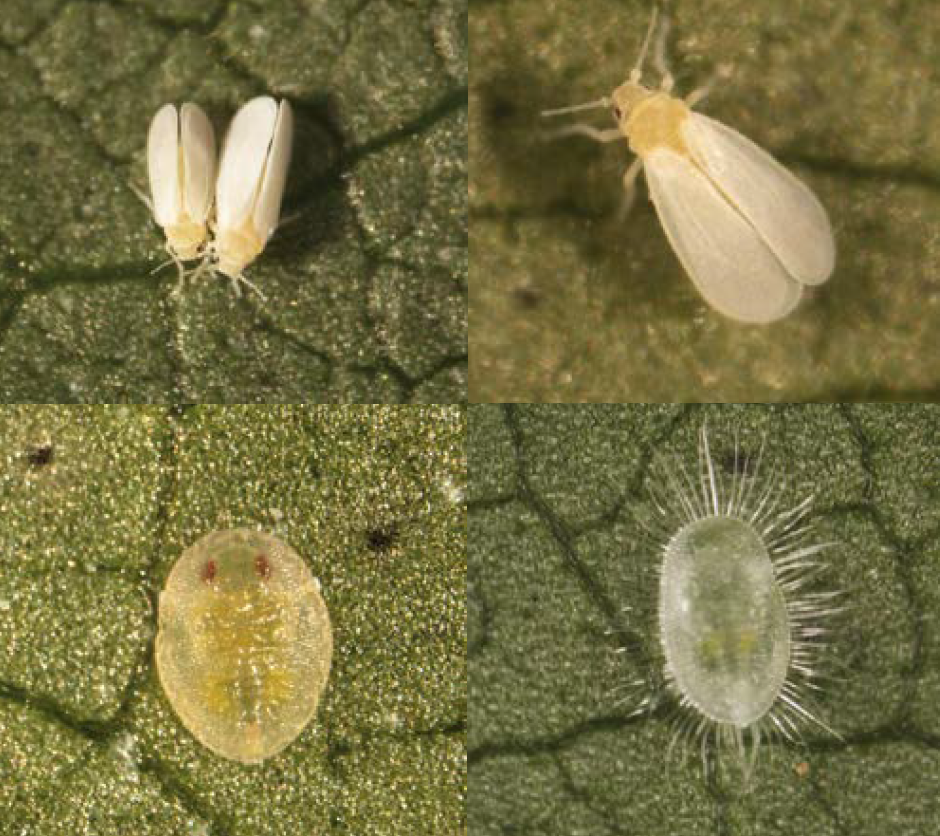Whiteflies are only a pest of broadleaf crops (e.g. cotton, sunflowers, pulses).
Silverleaf whitefly (SLW; Bemisia tabaci) is considered a major pest of cotton due to resistance issues and the difficulty in processing lint contaminated with SLW honeydew. Greenhouse whitefly (Trialeurodes vaporariorum) is a minor pest in broadacre cropping, but common in horticulture.
Description and damage
Adults are about 1.5 mm long with powdery white wings and a yellowish body. Most nymph stages are immobile and scale-like, attaching to the underside of leaves. Maturing SLW nymphs develop 2 red eye spots.

SLW (left) adults hold their wings at more of an angle than greenhouse whitefly (right) and the SLW nymphs lack hairs. (Photos Richard Lloyd)
The SLW life cycle from egg to adult can be as little as 18 days in the summer, but longer in cooler weather. The greenhouse whitefly life cycle is about 5–7 weeks in warm conditions. Summer and autumn are risk periods, with outbreaks favoured by warm weather and host availability.
Adults and nymphs suck on sap and excrete honeydew which can:
- interfere with photosynthesis
- promote the growth of sooty mould
- discolour the lint and cause problems with fibre processing in cotton.
The combination of high reproduction rate and short generation time can result in large populations that can retard plants simply through feeding. Under very heavy infestations, plants lose vigour, causing leaf-wilting and failure to set seed.
SLW is also a potential carrier of viruses not yet in Australia (such as cotton leaf curl).
Monitoring and management
Whiteflies can be present throughout the crop. High populations are normally an issue towards the end of the season unless there is adult migration from a nearby harvested crop.
Sampling methods and a decision support tool for SLW in cotton are discussed in detail at the CottonInfo website (along with information on a new app available to assist with sampling) and in the industry’s Cotton Pest Management Guide.
Conservation of natural enemies and good crop hygiene are key components in whitefly management. Avoid early-season use of broad-spectrum insecticides, particularly pyrethroids and organophosphates.
Predators include small predatory bugs, lacewing larvae and ladybirds. Parasitic wasps (Encarsia formosa and Eretmocerus spp.) usually provide effective biological control. Eretmocerus is available commercially for augmentative or inoculative release. Identification of parasitised nymphs is best done with a digital microscope.
SLW insecticide resistance
SLW has demonstrated an ability to develop resistance very quickly when insecticides are used repeatedly.
The Department of Agriculture and Fisheries conducts CRDC-supported insecticide resistance surveillance during the latter half of the cotton season on farms in Queensland and NSW. populations are collected and tested for their resistance to a range of products. As at June 2023, a moderate level of pyriproxyfen resistance had been detected in one population from Mungindi, with lower-level resistance present in two populations from the lower Namoi valley. Spirotetramat resistance was detected at a moderate level in a population collected from the Lockyer valley, while very low-level resistance was detected in five other populations from Emerald, St George, Mungindi, and the Namoi valley. No resistance has been detected to buprofezin so far.
Surveillance results from this and other surveillance programs by NSW DPI are incorporated into the annual update of the cotton industry’s integrated resistance management strategy (IRMS). The latest IRMS and other management information in the Cotton Pest Management Guide should be consulted before each pesticide application decision.
Further information
- Managing silverleaf whitefly in Australian cotton—CottonInfo factsheet
- Recognising parasitism in silverleaf whitefly
- Several silverleaf whitefly videos, including one on identifying parasitism are available on the CottonInfo YouTube channel(search for ‘whitefly’)
- Biological control suppliers include Biological services and Bugs for Bugs
- Check for registered products in the Australian Pesticides and Veterinary Medicines Authority (APVMA) PubCRIS database
